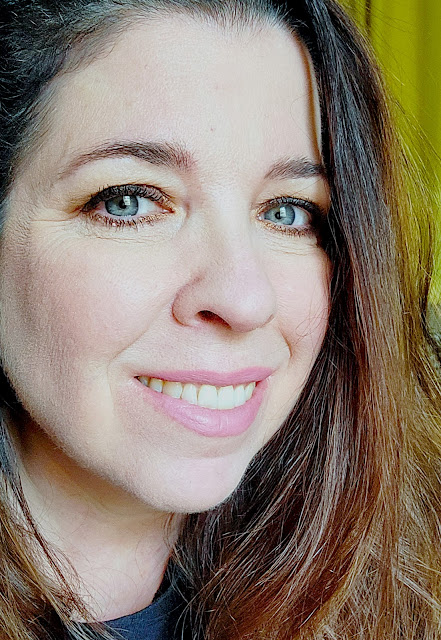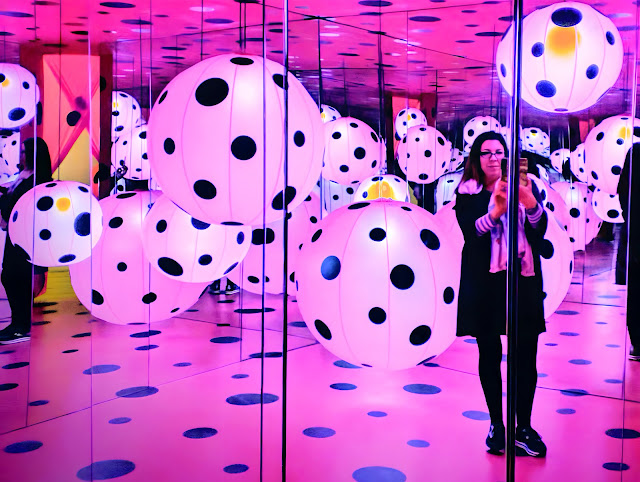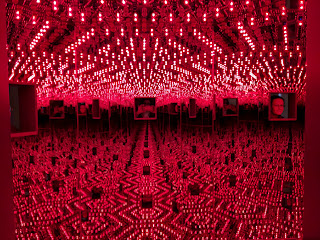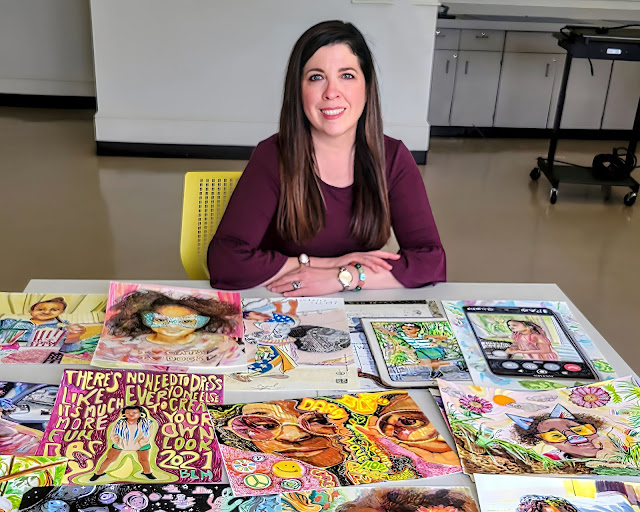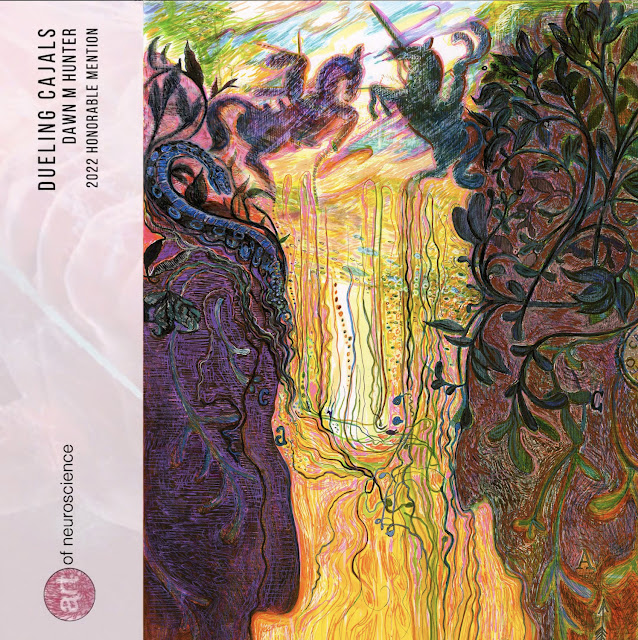Welcome to my latest blog entry, a space where the artistry of Santiago Ramón y Cajal, the legendary Spanish Neuroscientist, becomes the muse for a unique fusion of science and art. As an artist, professor, and Fulbright Scholar, I have the privilege of exploring and breathing "the life" of Cajal's intricate scientific sketches within the four walls of my studio. Just as the swirling hues of a nebula inspire the astronomer, the delicate complexities of Cajal's drawings breathe inspiration into my work.
Monday, June 19, 2023
Threaded Pathways: Unraveling Neuroscience and Art in Hannah Warming's Needles & Neurons
Wednesday, May 31, 2023
Cyber Canvas: Safeguarding Our Digital Nucleus in an Evolving Online Landscape
As an artist coaxes life from the austere medium of marble or a scientist awakens inquiry through the microscopic dance of cells, so too must we consider our digital imprint on the world wide web. A website, much like the nucleus of a cell, forms the crux of this complex tableau, defining, structuring, and fundamentally giving essence to our online identity. This isn't an analogy drawn frivolously; rather, it draws deep parallels with the magnificent designs of life. The nucleus is the cell's center, and it is filled with DNA blueprints that direct its function and purpose. A website is a meticulously curated digital fulcrum of our virtual existence, broadcasting our passions, capabilities, and contributions in a complex lattice of text, graphics, and links with code. On a website, we communicate who we are and what we do, shaping how the digital world perceives and interacts with us. Therefore, crafting this digital nucleus becomes an act of expression, blending the precision of science with the depth of art as we craft a coherent, authentic, and engaging narrative of our identity in the vast virtual cosmos.
The sanctity of our online nucleus, our website, is non-negotiable. Just as a biological cell enforces a membrane barrier against invading pathogens, the integrity of a website's domain needs safeguarding against digital marauders. These agents of chaos, armed with malevolent intent, seek to infiltrate our digital identities, corrupt our narratives, and compromise the authenticity of our self-expression. Thus, prioritizing domain protection is akin to maintaining the cellular health in a biological context. Ensuring robust security protocols, utilizing cutting-edge encryption, and regularly updating safeguards not only preserves our artistic or scientific endeavor in the virtual realm, it also guarantees the trust of those who interact with our domain. Much like an art historian would painstakingly preserve a masterpiece, or a biologist would protect a specimen, we must similarly guard our digital presence from degradation and corruption. The fortress we build around our online nucleus thus becomes a testament to our commitment to digital security, the preservation of our identity, and the respect for the spaces we inhabit and share in the digital universe.
As we navigate the nuanced landscape of digital presence, it's essential to understand the interplay between domain ownership and website hosting—two fundamental elements that, while closely intertwined, serve distinct functions. This distinction is akin to the difference between owning a precious artwork and having a secure gallery to display it. Domain ownership is your claim on a unique address on the web, your 'digital real estate,' if you will. It's the URL that directs users to your piece of the internet, much like the title of a painting guides art enthusiasts to a specific work. Website hosting, on the other hand, is akin to the gallery space where the artwork resides. It's a service that provides the infrastructure needed to display your website - the content, images, and features - on the internet. The domain brings your audience to your door, but it's the hosting that allows them to interact with everything inside. Both are indispensable in shaping and presenting your online identity, requiring strategic investment and judicious management for an engaging and secure online presence.
In the evolving digital landscape, the tactics employed by hackers have transformed into an intricate dance of deception, impersonation, and technical prowess. Their techniques echo the sophisticated forgeries of the art world, and just as the untrained eye may be fooled by a counterfeit, even the most seasoned online denizens can fall prey to such exploits. Recent developments have seen hackers impersonating reputable domain ownership and website hosting platforms, producing convincingly disguised emails to lure unsuspecting users into divulging sensitive information. This constitutes a form of phishing, where these digital miscreants masquerade as trusted entities, exploiting our reliance on these platforms and threatening the sovereignty of our digital nuclei. The deception is so intricate, the mimicry so convincing, that it lures the unwary into a dangerous game of trust, placing not just our personal data, but the very ownership of our online domains at risk. This digital art of deception, much like the craft of a master forger, is targeted towards creating opportunities for theft, underscoring the necessity of constant vigilance and fortified safeguards in our interactions with the digital world.
Should you find yourself ensnared in such an unscrupulous situation, it's essential to recall several key principles to safeguard your digital fortress. Firstly, remember that legitimate platforms hosting your domain or website will never request sensitive information pertaining to domain ownership via email. Their integrity is akin to that of a respected museum, preserving, not violating, your trust.
Secondly, if you own a premium website, like, for example, www.dawnhunter.com, no authentic platform will ever propose to auction off your domain, or cite its premium status as a reason list it in order to gain valuation insight on another platform. It's your masterpiece; they're simply the custodians.
Thirdly, it's imperative never to respond to or click on links within suspicious emails. Much like you wouldn't touch a fragile artifact in a museum without gloves, interacting with phishing emails can lead to irreversible damage. If you receive an email that looks authentic but raises suspicion, directly contact the supposed sender, such as your domain hosting or parking service, to verify its legitimacy. Never underestimate the power of double-checking, just as an art historian would verify a work's provenance.
Always ensure your domain remains locked, acting as the robust security system that protects valuable artworks in a gallery. If you observe dubious activity, it's not only permissible but encouraged to report such instances to ICANN or your local authorities. Like alerting museum security to potential threats, this proactive step can help maintain the security of the broader digital landscape, preserving the sanctity of our collective online expression.
In conclusion, our journey through the intersections of digital domain ownership, website hosting, and cybersecurity echoes the intricate choreography of The Dance: A Cell Block Tango Biological Pun, my recent artistic endeavor. This series, features figures emerging in the cell membrane, the nucleus, and the cytoplasm, and the inclusion of a painting from this series (along with a composition ideation landscape) in this article symbolizes the delicate balance we must maintain in crafting, curating, and safeguarding our digital identities. Like the dance of the cell, our online existence is a continuous ballet of expression, interaction, and vigilance. Our website—the nucleus of our online identity—demands the same respect, care, and protection as a cell in preserving life's vitality. It's essential to remain mindful of our potential challenges, understand the art of deception in the digital landscape, and equip ourselves with the knowledge and tools to protect our precious digital domains. In the end, our online presence is a canvas upon which we paint our intellectual, emotional, and creative identities; a masterpiece worth safeguarding with as much fervor as any priceless art or groundbreaking scientific discovery.
Thursday, December 22, 2022
Dawn Hunter | portrait of the visual artist in her fifties
In James Joyce's novel, A Portrait of the Artist as a Young Man, the narrative follows the journey of Stephen Dedalus, a budding artist grappling with his place in the world and cultivating his artistic identity. This modernist masterpiece is renowned for its inventive language and for depicting its main character's psychological and ethical growth.
From this literary work, mature creatives can glean that the metamorphosis into an artist encompasses a voyage of self-exploration and self-fashioning.
Attaining contentment and ease within oneself at any life stage is vital to one's overall wellness and can contribute to a more gratifying, purposeful existence.
Life is full of highs, lows, and transitional periods; however, it is crucial to remember that age remains a mere numeral and that it is never too late to chase your aspirations and objectives. Numerous people find a renewed sense of direction and focus as they age and view aging as an opportunity for reinvention and to make positive life changes. Often people will choose to prioritize their personal development and joy.
Remember that there's no "right way" to be a fabulous 50-something (or any age, for that matter). It's so important to appreciate our own unique qualities, talents, and passions. If you're feeling excited about this chapter in life like I am, that's amazing! Let's keep celebrating our individuality and living life to the max!
My Story
Age has never dictated the course of my life. I've always pursued a creative path; each day spent in my studio feels timeless. This creative space fosters a connection between various moments and locations throughout my life, all within the artistic process. Additionally, I teach first-year college students who are full of energy, creativity, and innovation. These young individuals inspire and graciously invited me into their lives through our shared artistic pursuits.
A hurdle that older female artists might encounter is ageism, which is discrimination based on age. This can manifest in various ways, such as being overlooked for opportunities or being treated differently due to one's age.
Another obstacle older female artists may face is inadequate representation and support for their work. It is not unusual for them to feel as if their artwork doesn't receive the same level of attention or acknowledgment compared to their younger peers.
Yet, despite these obstacles, numerous older female artists remain committed to producing and showcasing their art. They may discover support and fellowship within artistic circles and could even find that their age and life experiences provide them with a distinct viewpoint and expression in their craft. (Above, a portrait of Dawn Hunter. Photo captured by Darcy Phelps.)
My Inspiration
Above, self-portrait of Dawn Hunter at the Yayoi Kusama exhibition in Atlanta, Georgia. Left, the Peep Show light installation by Yayoi Kusama, photo by Dawn Hunter.
*Ticket scalping has become a more common practice during the past twenty years because of the internet. Most scalping incidents now take place through online sales transactions. Currently, there are no federal laws that prohibit the scalping or resale of tickets.
Above, the obliteration room at the Yayoi Kusama Exhibition at the High Museum, photo by Dawn Hunter.
Closing
2022 has been an excellent year for me creatively, and I was productive - generating many new works of art throughout the year. I have been honored by the recognition and success of my illustrations, drawings, and paintings about the esteemed neuroscientist Santiago Ramón y Cajal and my daughter, Darcy. I have exhibited throughout the US this year, from Art Fields in Lake City, SC, Verum Ultimum, Portland, OR, and the Cabrillo Gallery, Los Angeles - to name a few 2022 exhibition highlights.
I feel sincere gratitude for being the first artist to be elected to the Board of Directors of the prestigious Cajal Club and for the distinctions of having my artwork reproduced and written about in Scientific American® and the Consilience Journal.
I look forward to opportunities and the creative journey ahead of me in 2023, and as the sayings go, "age is just a number," and "being fifty is nifty."
Portrait of Dawn Hunter taken by her daughter Darcy as they prepared the Darcy Inventory for the 2022, 10th Anniversary Artfields exhibition, Lake City, SC.
Saturday, September 17, 2022
Mentorship and Loss
Ah, you know, being a college art student is such an adventure! You've got that snazzy studio space to create your masterpieces, but it can feel lonely sometimes. I can't stress enough how crucial it is to have a mentor in your college art studio. They're like a lighthouse in a stormy sea of creativity!
Mentors, they're like these magical beings who guide you, give feedback on your work and help you network with other artsy folks. The hallmark of a good mentor is excellent listening skills balanced with professional experience and generosity. Having someone committed to providing quality and consistent feedback nurtures your creative present and future.
Let me tell you where to start if you're looking for a mentor.
First up, your professor; if there's a professor you genuinely admire and who knows their stuff about your preferred art form, they might be the mentor of your dreams! Ask if they can spare some time regularly to chat about your work and offer their insights.
Next is the college art gallery; those gallery staff members are usually eager to gab about art with students. If there's an artist or style you're really into, ask a staff member if they can point you toward a potential mentor.
And remember local artists! Your town or city is probably teeming with artists who'd be thrilled to mentor a budding college student. Check out local galleries and studios, and don't be shy—say hello to and regularly interact with the artists of your community. Having a mentor in your college art studio can be transformative for you creatively but also set you on a productive career path. So, reach out and ask for help!
My Mentors
During my college years at the Kansas City Art Institute, I was never shy about reaching out to professors. I was lucky in college, I had two great mentors who shaped my artistic practice profoundly: Wilbur Niewald and Shirley Luke Schnell.
Wilbur Niewald
Wilbur Niewald died this past spring at the age of 97. He live his entire life in Kansas City, and no one has painted the city as frequently as he did. His Plein air works could rightfully be called love letters to the city.
Wilbur earned bachelor and master degrees from the Kansas City Art Institute. He was a member of the painting faculty for 43 years, chaired the painting department from 1958 to 1985, and was a respected and well known painter throughout the United States.
In 1992, he retired. He remained devoted to his artistic practice and he spent hours each day, often six days a week, painting outdoors in Loose Park or the West Bottoms or in his studio during his retirement.
One of the things I liked to do when visiting Kansas City in the summer was to visit him while he was creating his Plein air artworks. I would find him passionately painting away at his easel near the tennis courts at Loose Park in Kansas City, Missouri, wearing his well-known attire: a straw hat, denim shirt, and blue jeans.
I took Wilbur's drawing classes most semesters while I was in college. Every class was always the same, with one instruction: "Draw what you see." I found the experience meditative and relaxing, and I also developed a deep appreciation for working from observation.
Wilbur always took me seriously and respected me as an artist, which profoundly impacted me the most. I took myself seriously because of that. He understood my potential more than I did. As a sophomore, I had a conversation with him about switching my major from Painting to Fibers. He made a compelling argument to other faculty and me in the program about why I should not switch my major. I stayed because he convinced me.
He drew and painted from direct observation beginning in the 1970s. It never mattered to him what the condition of weather was. Once when our drawing class was outside drawing the landscape in Plein air, it began to rain. Most students began packing up and heading back to the classroom, but Wilbur exclaimed, "Don't leave; this is great. Change your drawing as the situation changes." He only convinced four of us to stay.
Shirley Luke Schnell
There's nothing quite like a quirky art professor to get students excited about creativity. Shirley Luke Schnell was one of those teachers. With her whimsical, soft-spoken voice and eccentric clothing, she always seemed to be on the verge of levitating above all of us in the Foundations studio. But somehow, she always managed to bring unique and memorable insight to the studio practice, and her students always seemed inspired and to learn a lot.
Even though she was different than anyone else you'd ever meet, her students connected with and loved her. They knew that she cared about them and that she wanted them to succeed. She was always pushing them to be their creative limits with the concepts of her assignments. This generated growth and new perspectives on what is or could be.
Shirley is a true original, and in the classroom, she was the perfect example of how being different can be a good thing. After Foundations, I reached out to her for critiques of my paintings and help with my graduate school applications. She was fully invested and took time during her weekends to help me write my application essays with clarity. I was fortunate to have her mentorship after college, too. We became close friends, and she has been present for the significant milestones of my life. Such as visiting me in London during my residency at the Royal Academy of Arts and attending my wedding.
Embracing Change: The Journey with Alzheimer's
As we grow older, it's not uncommon for memory to fade, impacting both ourselves and our dear ones. When it comes to Alzheimer's, this shift can be particularly tough on relationships. I remember my incredible mentor, Shirley, who was officially diagnosed with Alzheimer's back in 2013.
Looking back, he signs were there even before her diagnosis—visible in her actions and words. Today, she's reached a non-verbal stage as the disease continues its progression. Though she's still with us, Alzheimer's has taken away so much. Let's cherish our memories and support those facing this journey.
1. Understanding Alzheimer's: A Battle of the Mind
Alzheimer's, one of the most common types of dementia, has touched the lives of over 5 million Americans. As a neurodegenerative disorder, it slowly erodes our memory and cognitive functions, making every day a struggle. Despite the efforts of researchers, the cause is unknown. Its cause is theorized to be a blend of genetic and environmental factors. The cure remains undiscovered.
2. Recognizing the Signs: Encountering Alzheimer's Symptoms
Living with Alzheimer's can be an incredibly personal and unique experience, as the symptoms manifest differently for everyone. Yet, some common threads bind these journeys: the challenges with memory, thinking, and communication and the shifts in mood and behavior.
Physical symptoms like trouble walking, dizziness, and appetite changes also make their presence known, adding to the daily battles faced by those with Alzheimer's.
3. How does Alzheimer's disease affect relationships?
Alzheimer's disease can be heart-wrenching, profoundly affecting our relationships with loved ones. Those with this condition might withdraw from socializing, struggle to recall names or faces, and even become disoriented or agitated. As friends and family, it's painfully difficult to watch someone we care for seemingly disappear from us.
But let's not forget that beneath the disease; their hearts are still capable of feeling love and affection. We must keep embracing them, even when communication becomes a challenge. Engage them in activities they've always loved, and practice patience and understanding. Together, we can make sure they never feel alone in their fight.
Loss
Losing a mentor—whether through death or illness is difficult.
Whether it hits you like a bolt from the blue or you see it coming, the passing of a mentor can feel like a shock. You may feel a great sense of emptiness after losing someone like the North Star guiding your ship, helping you grow and learn!
When a mentor leaves this world, it's easy to feel adrift and unsure. Let's remember that your mentor would want you to continue and keep growing creatively.
It is essential to pause, allow yourself to grieve, and then remind yourself that your mentor would be cheering you on to keep putting one foot in front of the other and pay it forward by mentoring a younger artist yourself!
Friday, August 26, 2022
Six Month Studio Round Up
Darcy and her back-to-school summertime braids weaved by yours truly, and my White Daisy mixed media drawing completed at the Riverbanks Zoo.
Spring Exhibitions
Summer Fun
Darcy, outside of World Explorers camp, Greenville, SC.
Art of Neuroscience, Netherlands Institute of Neuroscience
I received an Honorable Mention for my artwork Dueling Cajals in the prestigious international sci-art competition, Art of Neuroscience. This year's competition jurors were Dr. Bevil Conway, Dr. Flora Lysen, and Dr. Sabine Niederer.
Netherlands Institute for Neuroscience Statement:
"This submission struck the jury because of its emphasis on the history of neuroscience. The work highlights how any scientific process, particularly scientific image-making, can be influenced by a multilayering of cultural and historical factors. The jury admired how diverse periods in time from this historical perspective were weaved into one image, and appreciated the effort that went into investigating the sources that Cajal was exposed to. Dueling Cajals serves as an important reminder for neuroscientists to recognize history and its influence on their work. " - AoN, NIN, NL







